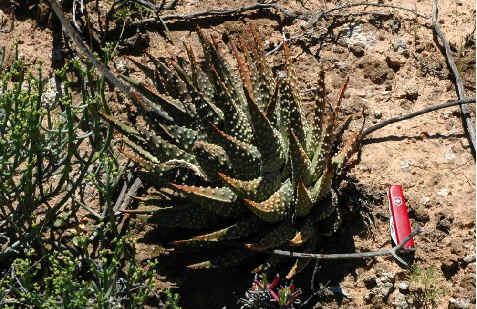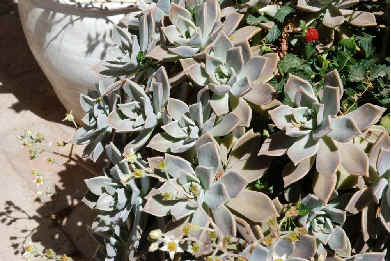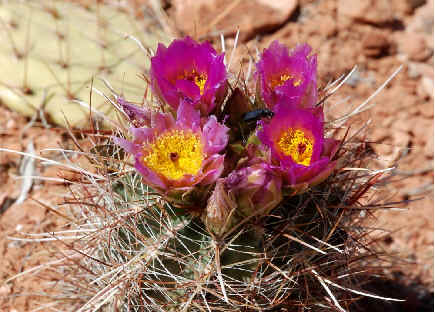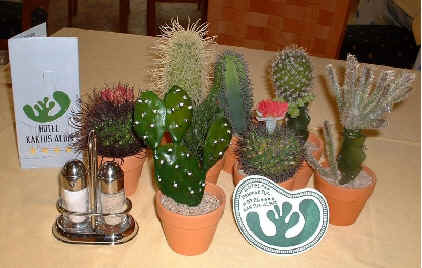|
I bought a Haworthia pumila seedling many, many years ago. ‘Pumila’ means small and my purchase was certainly small. I like to buy small plants, they are good value! However the plant grew and soon was the largest of my Haworthias. It had leaves covered in white tubercles and was quite attractive in a robust sort of way. When I looked it up in my Pilbeam’s Haworthia book I learned it was indeed the biggest Haworthia; how could it possibly be that this plant, growing to a foot, (or 30 of those new fangled centimetres), had the Latin name pumila? Seems it was first described as an Aloe in 1753. Now as an Aloe it is certainly small, hence the name. Soon it became apparent that the small white flowers were nothing like the other Aloes, mostly with bigger bright red or yellow blooms. I was lucky enough to see this species in habitat at Worcester, South Africa. It was tucked in the shade among succulent shrubs; mostly Mesembs, Crassulaceae, stick Euphorbias and Othonnas. Oh, and there was the odd Aloe microstigma around and it seems strange when you see them together that this and Haworthia pumila were considered to be closely related. Grow H. pumila if you have room. It will make a large plant eventually but I am sure it can be grown in some shade under the staging. It is difficult to grow a perfect specimen – the leaf tips dry up at the first hint of drought – but they also do this in habitat as well. |
Above: Haworthia pumila in habitat near Worcester, SA. The ‘small’ Haworthia is in fact the biggest! |
|
|
If I were to ask you where Graptopetalum paraguayense comes from you would answer immediately Mexico! Northants News readers are very knowledgeable but you might wonder how the species got a name that means ‘coming from Paraguay’. Seems this plant was accidentally introduced (it sprouts quickly from leaves and seeds), with some cacti imported ‘from Paraguay’ and the provenance stuck. Graptopetalum paraguayense is an easy plant to grow and will tolerate a fair bit of frost. It is an excellent patio plant. I have seen plants in the Midlands overwintered outdoors against a wall. It is the parent of many vigorous hybrids with related North American members of the Crassula family, Sedum, Echeveria and the like. There is a subspecies bernalense which is paler and smaller but still quite easy. Strangely enough I have not grown it for years and had no photo for this article. I scrounged a cutting and in case it didn’t grow quickly enough, I had an email penned to the owner of an internet image, just in case I got desperate. However I came across an attractive cluster in a garden in Aberdeen. That’s Aberdeen in the Karoo, South Africa; a long way from home! Gymnocalycium paraguayense is from Paraguay. As you would expect. |
| Graptopetalum paraguayense growing in a South African garden. |
|
A third member of this group with misleading names is Sclerocactus parviflorus. The specific name means ‘small flowered’ but in fact this can be one of the largest flowering species. Only S. polyancistrus has larger flowers. The misnomer arrives via taxonomic confusion with S. whipplei which has got small flowers and is so complicated I am sure it is not for the pages of NN. However when you see the magenta flowers of Sclerocactus parviflorus blazing out in the desert just remember that ‘parvi’ means big in this situation. I am sure there are many other inappropriate names for cacti and succulents. The only other I can think of is Hildewintera polonica (a Polish cactus?) but this is an invalid name which it is a good idea to discourage. While researching this subject I came on a website featuring strange Latin names which was a good read. You should have a glance. This drew my attention to an obvious one. Opuntia is widely said to derive from the Latin ‘Opuntius’, a native of the ancient Greek city of Opus where Pliny thought it occurred. My Etymological Dictionary reckons it more likely comes from the Greek ‘opus’ for the fig-like fruits or a composition from the Aztec ‘’nopalli’ and the Latin ‘pungere’ to prick or sting. Take your choice! Do readers know of any other misnomers in the cactus / succulent world? Trev |
|
|
Above: Sclerocactus parviflorus seen at Pipe Springs National Monument, Arizona. Large flowers on the ‘small flowered’ Sclerocactus |
|
The Cactus Connection Trevor Wray |
|
|
NN’s favourite rare US cactus reporter Don Campbell sends us this image (left) from his recent Oregon vacation. (They don’t have holidays there.) Not a lot to do with cacti or succulents but that’s Northants News for you. Apparently this venue which maybe believes in truthful adverts is on US101. By contrast the Ed of NN likes to keep his mind on topic so here is an image (right) of the Cactus Tearoom and Bistro in Weymouth. Unfortunately it was 29th December and we couldn’t test the décor as the shop was closed
|
|
|
When the Wray’s went to Spain to celebrate Dad’s eightieth we had a choice of hotels but the Hotel Kaktus in Albir gave us a BCSS discount, (well, there were eight of us and it was January as well). Tasteful plastic cacti abounded; one on every table in the restaurant. The staff were perplexed when we gathered them together for the group photograph. ‘A BCSS ritual’ we said. ‘Ah, si, signor’. You will note that the difficult-to-grow plastic species are grafted, (on hardy plastic stock). There were big ones as well at reception, also plastic. These appeared to be saguaros, (Carnegiea gigantea), but for the leaves on top. Perhaps a Euphorbia? At least there were no mealies. A nice hotel I would visit again, (if only to see how the cacti had grown!). Trev (I just know the taxonomists who avidly read NN will want to study the species illustrated here. You can click for a better image)
|
|






